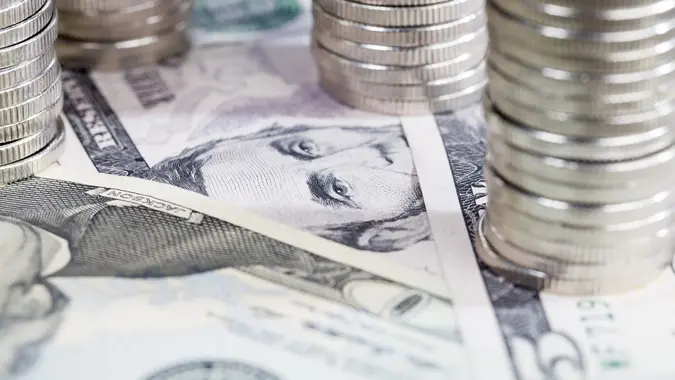What Is a Dividend Rate on a CD?

Commitment to Our Readers
GOBankingRates' editorial team is committed to bringing you unbiased reviews and information. We use data-driven methodologies to evaluate financial products and services - our reviews and ratings are not influenced by advertisers. You can read more about our editorial guidelines and our products and services review methodology.

20 Years
Helping You Live Richer

Reviewed
by Experts

Trusted by
Millions of Readers
If you are considering opening a CD account to grow your savings, you might find yourself wondering, “Do CDs pay dividends?” It’s a common question for anyone looking to diversify their investment portfolio and seeking alternatives to traditional savings. Understanding how CDs function, particularly in terms of interest earnings, is key to making informed decisions about your financial growth strategy.
Dividend Rate on a CD: What You Should Know
A dividend rate reflects how much you will receive for storing your money in a CD, although this payment is usually referred to as interest instead of a dividend. It reflects how hard your money is working. For instance, a CD with a 4.00% APY will yield more than a CD with a 3.00% APY. Credit unions often use the term dividend rate to describe how much you can earn by keeping your money in a CD.
Do CDs Pay Dividends or Interest?
Certificates of deposit do not pay dividends in the traditional sense like stocks do. Instead, CDs earn interest. This interest is similar to the returns from a bond or savings account, accruing over the CD’s term. Banks pay interest, but credit unions give out dividends for share certificates, which function similarly to CDs. When considering the best CD rates, it’s important to note that the interest rate determines the earnings from a CD, not dividends.
How a CD Dividend Rate Works
Both banks and credit unions offer CDs, though a credit union might refer to their product as a share certificate. When you purchase a CD, you agree to deposit a certain amount of money with the institution for a fixed term, which can range from a few months to several years. In exchange for committing your funds for this period, the bank offers you an interest rate typically higher than that of a regular savings account.
Banks and credit unions specify how much the dividends compound in your CD. Daily compounding will increase your earnings compared to monthly compounding. More frequent compounding increases your balance, and a higher balance translates into higher dividend payments.
Here are some key takeaways to know:
- During the term of the CD, you are expected not to withdraw the funds. Withdrawing early can result in penalties, reducing your overall return.
- The interest rate on a CD is fixed at the time of opening the account and remains constant throughout the term, protecting you from interest rate fluctuations.
- Upon maturity, you have a few options: you can withdraw your initial deposit plus the interest earned, renew the CD for another term or possibly transfer the funds to a different investment.
- CDs are a predictable, low-risk investment choice for those looking to grow their savings steadily without exposure to market risks.
Is a CD Dividend Rate the Same as an Interest Rate?
CD dividend rates function in the same way as interest rates. These figures let you see how much you will receive in return for depositing money into a CD. Many banks and credit unions list the APY which reflects dividend and interest payments. You won’t earn any more or less whether you receive dividend payments or interest payments. Consumers should focus on a CD’s APY.
Advantages of CDs That Pay Dividends
CDs offer several benefits that appeal to a range of investors, particularly those seeking stability and predictability in their investment portfolio.
Security
CDs are known for their security. They offer guaranteed returns, making them a safe investment choice. Unlike stocks or mutual funds, the return on CDs is predictable, providing peace of mind for investors who prioritize stability over high-risk gains.
Competitive Fixed Interest Rates
Another significant advantage of CDs is their fixed interest rates. This feature is particularly attractive in an unpredictable market. With fixed rates, investors can calculate their exact earnings at the end of the CD term, enabling precise financial planning. These rates are also quite competitive compared to other bank accounts.
Low Entry Threshold
CDs often have a relatively low minimum deposit requirement, making them accessible to a wide range of investors. This low entry threshold allows individuals to start investing with a smaller amount of capital while still enjoying the safety and predictability CDs offer.
Member Ownership and Profit Sharing Benefits
Credit unions are not-for-profit organizations that are obligated to share their profits with their members. That results is that the CD or certificate offerings tend to have more competitive APYs than traditional banks. Credit unions typically refer to their payments as dividends, while banks usually refer to their payments as interest.
How To Compare CD Dividend Rates
You can compare CD dividend rates by checking each account’s APY. Higher APYs will give you more dividends, but you also have to check the term length. Some CDs have high rates that only last for a few months, while a long-term CD offers more stability.
Credit Unions vs. Banks: Where To Get the Best CD Dividend Rates
Credit unions are non-for-profit corporations which means they must give more of their profits to members. Banks are not under the same obligation, and that translates into different dividend rates. Credit unions usually have higher CD dividend rates than traditional banks. However, traditional banks usually offer a wider selection of financial products than credit unions.
Selecting the Best CD Account
Selecting the best CD for your investment involves more than just hunting for the highest rates. Consider the following factors:
- Term length: Can range from a few months to several years.
- The minimum deposit required: Can vary widely among institutions.
- Early withdrawal penalty: Impacts your returns if you access your funds before the CD matures.
Comparing offerings from various banks and credit unions can help you find a CD that aligns with your financial goals and timeline.
Final Take
To sum up, while CDs do not pay dividends, they offer a reliable interest-based return, making them a valuable component of a diversified investment strategy. If you’ve been wondering “what is a dividend rate on a CD?”, the key is to find the best CD rates to make the most from your investment returns. Remember, the goal with CDs is steady growth, not the dividend income typically associated with stocks.
CD Dividend FAQ
Here are the answers to some of the most frequently asked questions regarding CD dividends.- Do CDs earn interest or dividends?
- While it's the same amount of money based on the APY, some CDs pay dividends while others pay interest. Credit unions usually have dividend-paying CDs, while traditional banks have interest-paying CDs.
- How is a CD dividend rate calculated?
- A CD dividend rate is calculated based on the principal and the dividend payment. For instance, if a consumer receives $40 from a $1,000 CD balance, that CD has a 4% dividend rate.
- What is the difference between a dividend rate and an interest rate?
- A dividend rate refers to how much dividends you will receive from your balance, while an interest rate refers to the amount of interest you will earn.
- Are dividend rates on CDs better at credit unions?
- Yes. Credit unions typically have higher CD rates than banks since they are obligated to distribute their profits among members.
 Written by
Written by  Edited by
Edited by 

























